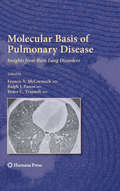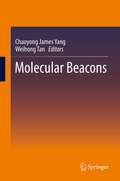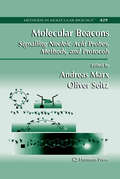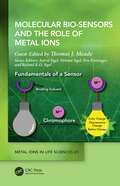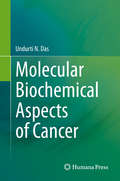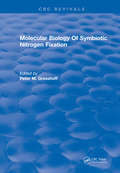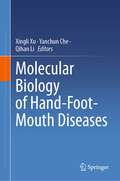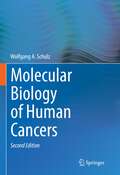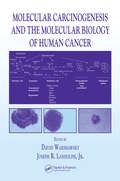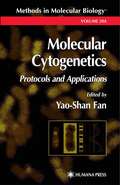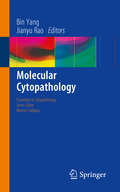- Table View
- List View
Molecular Basis of Health and Disease
by Undurti N. DasThe book describes how the balance between pro- and anti-inflammatory molecules is related to health and disease. It is suggested that many diseases are initiated and their progress is influenced by inflammatory molecules and a decrease in the production and/or action of anti-inflammatory molecules and this imbalance between pro- and anti-inflammatory molecules seems to have been initiated in the perinatal period. This implies that strategies to prevent and manage various adult diseases should start in the perinatal period. An alteration in the metaolism of essential fatty acids and their anti-inflammatory molecules such as lipoxins, resolvins, protecitns, maresins and nitrolipids seems to play a major role in the pathobiology of several adult diseases. Based on these concepts, novel therapeutic approaches in the management of insulin resistance, obesity, type 2 diabetes mellitus, metabolic syndrome, cancer, lupus, rheumatoid arthritis and other auto-immune diseases are presented. Based on all these evidences, a unified concept that several adult diseases are due to an alteration in the balance between pro- and anti-inflammatory molecules is discussed and novel methods of their management are presented.
Molecular Basis of Multiple Sclerosis
by Roland Martin Andreas LutterottiDespite major efforts by the scientific community over the years, our understanding of the pathogenesis or the mechanisms of injury of multiple sclerosis is still limited. Consequently, the current strategies for treatment and management of patients are limited in their efficacy. The mechanisms of tissue protection and repair are probably even less understood. One reason for these limitations is the enormous complexity of the disease and every facet of its pathogenesis, the mechanisms of tissue injury, the diagnostic procedures and finally the efficacy of treatments and their side effects. The aim of this book is to review the most recent advances made in this highly complex field.
Molecular Basis of Pulmonary Disease
by Bruce C. Trapnell Ralph J. Panos Francis X. MccormackThe study of rare lung disorders enhances our understanding of common pulmonary diseases such as fibrosis and emphysema. Molecular Basis of Lung Disease: Insights from Rare Disorders brings together a panel of distinguished clinicians and molecular scientists who are experts in a range of rare lung diseases and their underlying molecular defects. Each chapter focuses on the pathogenic mechanisms and therapeutic targets suggested by basic research and follows an easy to read format: brief introduction followed by discussion of epidemiology, genetic basis and molecular pathogenesis, animal models, clinical presentation, diagnostic approaches, conventional management and treatment strategies, as well as future therapeutic targets and directions. Disorders ranging from the Marfan and Goodpasture's syndromes to Sarcoidosis and alpha one antitrypsin deficiency are treated in detail. Written for pulmonary clinicians and scientists alike, Molecular Basis of Lung Disease: Insights from Rare Disorders is a comprehensive and invaluable resource that sheds new light on the molecular mechanisms influencing the clinical presentation and treatment strategies for these debilitating disorders.
Molecular Basis of Resilience: Adapting to a Changing Environment
by Patrick L. IversenThis book illuminates mechanisms of resilience. Threats and defense systems lead to adaptive changes in gene expression. Environmental conditions may dampen adaptive responses at the level of RNA expression. The first seven chapters elaborate threats to human health. Human populations spontaneously invade niche boundaries exposing us to threats that drive the resilience process. Emerging RNA viruses are a significant threat to human health. Antiviral drugs are reviewed and how viral genomes respond to the environment driving genome sequence plasticity. Limitations in predicting the human outcome are described in “nonlinear anomalies.” An example includes medical countermeasures for Ebola and Marburg viruses under the “Animal Rule.” Bacterial infections and a review of antibacterial drugs and bacterial resilience mediated by horizontal gene transfer follow. Chapter 6 shifts focus to cancer and discovery of novel therapeutics for leukemia. The spontaneous resolution of AML in children with Down syndrome highlights human resilience. Chapter 7 explores chemicals in the environment. Examples of chemical carcinogenesis illustrate how chemicals disrupt genomes. Historic research ignored RNA damage from chemically induced nucleic acid damage. The emergence of important forms of RNA and their possible role in resilience is proposed. Chapters 8-10 discuss threat recognition and defense systems responding to improve resilience. Chapter 8 describes the immune response as a threat recognition system and response via diverse RNA expression. Oligonucleotides designed to suppress specific RNA to manipulate the immune response including exon-skipping strategies are described. Threat recognition and response by the cytochrome P450 enzymes parallels immune responses. The author proposes metabolic clearance of small molecules is a companion to the immune system. Chapter 10 highlights RNA diversity expressed from a single gene. Molecular Resilience lists paths to RNA transcriptome plasticity forms the molecular basis for resilience. Chapter 11 is an account of ExonDys 51, an approved drug for the treatment of Duchenne muscular dystrophy. Chapter 12 addresses the question “what informs molecular mechanisms of resilience?” that drives the limits to adaptation and boundaries for molecular resilience. He speculates that radical oxygen, epigenetic modifications, and ligands to nuclear hormone receptors play critical roles in regulating molecular resilience.
Molecular Beacons
by Chaoyong James Yang Weihong TanMolecular Beacons explains working principle of molecular beacons, discusses their design, synthesis, purification and characterization, explores their thermodynamic and kinetic properties, and more importantly, reviews their in vivo and in vitro applications with the emphasis on the design and modification of molecular beacons for in vivo mRNA imaging applications. This book is designed to bring together in a single resource an organized and comprehensive view of molecular beacons and will be a valuable resource for academic, clinical and industrial scientists and graduate students who may consider exploring molecular beacons in their research or practice. Chaoyong James Yang is the Lu Jiaxi Professor of Chemistry at Xiamen University, China. Weihong Tan is a Distinguished Professor of Chemistry and Biomedical Engineering at Hunan University, China and also a University of Florida Distinguished Professor and V. T. and Louis Jackson Professor of Chemistry at the University of Florida, USA.
Molecular Beacons: Signalling Nucleic Acid Probes, Methods, and Protocols
by Oliver Seitz Andreas MarxFrom probe design to applications in clinical settings, this book provides a diverse set of instructive examples, guided by experts in the field who offer easy-to-follow experimentals. The book first offers an introduction to the basic principles of fluorescence and then describes applications of fluorogenic probes in real-time PCR, which currently is the gold standard for quantitative DNA and RNA analysis. Coverage extends the potential of realtime as well as advocates simplifications of the probe technologies. It also presents a new simplified molecular beacon design, EasyBeacons, and demonstrates the utility in DNA methylation profiling.
Molecular Bio-Sensors and the Role of Metal Ions (Metal Ions in Life Sciences Series)
by Astrid Sigel Helmut Sigel Thomas J. Meade Eva Freisinger Roland K.O. SigelVolume 23, entitled Molecular Bio-Sensors and the Role of Metal Ions, of the series Metal Ions in Life Sciences (MILS) represents a milestone of contemporary progress and understanding of molecular bio-sensors for metal ions. It is bringing together the latest research in academia and industry, and it also emphasizes the spectrum of evolving regulations from regulatory bodies. This vibrant research area is covered by 31 internationally recognized experts. The impact of MILS-23 is manifested by more than 1300 references and close to 200 figures, more than 100 of them in color; further information is summarized in several tables. In conclusion, Volume 23 significantly advances our understanding of Molecular Bio-Sensors, it is therefore an essential resource for scientists working in the wide range from earth sciences, material sciences, physics, pharmacology, enzymology, analytical, organic, and inorganic biochemistry all the way through to medicine including the clinic. • It provides an understanding of the roles that metals play in living systems. • It offers an insight for the demands needed in the clinic. • It reveals the interplay between bio-sensors and therapies. The Series METAL IONS IN LIFE SCIENCES increases our understanding of the relationship between the chemistry of metals and life processes. The volumes reflect the interdisciplinary nature of Biological Inorganic Chemistry and coordinate the efforts of researchers in fields like biochemistry, inorganic chemistry, coordination chemistry, molecular and structural biology, enzymology, toxicology, environmental chemistry, biophysics, pharmacy, and medicine. The volumes deal with the formation, stability, structure, and reactivity of metal-containing biological compounds of low and high molecular weight. The metabolism and transport of metal ions and their complexes as well as new models of complicated natural structures and processes are in the focus. Consequently, the volumes are an essential source for researchers in the mentioned fields as well as for teachers preparing courses, e.g., in Bioinorganic Chemistry.
Molecular Biochemical Aspects of Cancer
by Undurti N. DasThis book discusses the role of genes, oncogenes, anti-oncogenes, free radicals, PUFAs, anti-oxidants, lipid peroxidation process, telomere, and angiogenesis on the origin of cancer, cell proliferation, and cancer in general. It includes a broad introduction to cancer cells; genes, oncogenes, and anti-oncogenes; and free radicals. In later chapters, it discusses in depth the relationship among free radicals, lipid peroxidation and anti-oxidants in cell proliferation. It also discusses aerobic and anaerobic metabolism and their relationship to cancer, as well as the Warburg effect and its potential in the development of new targets for cancer management. Based on these and other evidences, Molecular Biochemical Aspects of Cancer introduces a novel concept that suggests that selective enhancement of free radical generation in tumor cells could form a strategy to induce apoptosis of cancer cells employing bioactive lipids. It presents a new method of treatment of cancer using in vitro, in vivo and clinical data. This book will interest oncologists, scientists, molecular biologists, life scientists.
Molecular Biochemistry of Human Disease: Volume 2 (Routledge Revivals #3)
by George Feuer F. A. de la IglesiaFirst published in 1986: This book is to help medical, pharmacy, and advanced students in science to understand the growing importance of continuously advancing biochemical concepts in human disease.
Molecular Biochemistry of Human Diseases: Volume 2 (Routledge Revivals #3)
by George Feuer F. A. de la IglesiaFirst published in 1986: This book is to help medical, pharmacy, and advanced students in science to understand the growing importance of continuously advancing biochemical concepts in human disease.
Molecular Biology Of Symbiotic Nitrogen Fixation
by Peter M. GresshoffThe core of the text is aimed at the research worker in the field of nitrogen fixation, but, despite its specialisation, does not lose the emphasis on teaching, both as a direct reference book and as a backbone for a graduate course on the subject.The closing part of the book includes a subject index and a glossary of terms. The latter was included not for the expert, for whom many of the definitions will be too general, but for the newcomer; the author hopes that the quick survey of key terms will help in the reading of this book.
Molecular Biology and Pathogenesis of Peste des Petits Ruminants Virus
by Muhammad Munir Siamak Zohari Mikael BergPeste de Petits Ruminants (PPR) is a highly contagious viral disease of domestic and wild small ruminants that can significantly affect economies. The authors are experts in the field and provide an up-to-date and comprehensive review covering all aspects of the disease. The book is divided into seven chapters highlighting genome organization, virus replication and the determinants of virulence, pathophysiology and clinical disease, immunology and immunopathogenesis, epidemiology, diagnostic assays and vaccines, and the challenges concerning global eradication. It is an invaluable reference work, presenting the latest information for virologists, microbiologists, immunologists, veterinarians, and scientists working in PPR research.
Molecular Biology of Assemblies and Machines
by Alasdair Steven Wolfgang Baumeister Louise N. Johnson Richard N. PerhamMolecular Biology of Assemblies and Machines provides a comprehensive narrative of the ways in which macromolecular structures assemble and how they interact with other complexes and organelles in the cell. Richly illustrated in full color, the text is written for advanced undergraduates, graduate students, and researchers in biochemistry, molecular biology, biophysics, cell biology, chemistry, structural biology, immunology, microbiology, and medicine.
Molecular Biology of Cancer: Mechanisms, Targets, and Therapeutics
by Lauren PecorinoMolecular Biology of Cancer: Mechanisms, Targets, and Therapeutics offers an accessible, engaging, and optimistic account of cancer biology for undergraduate and graduate students. <p><p>Using the hallmarks of cancer as a starting point, the book looks at the cellular and molecular mechanisms underpinning the transformation of cells into cancer cells. After discussing the theory, each chapter then demonstrates how this knowledge can be directly applied to the development of new targeted therapies, giving the reader a clear appreciation of how our understanding of the theory can be translated into new approaches for tackling the disease. <p><p>The new edition draws on the latest research in cancer biology, highlighting fundamental concepts and re-emphasizing pre-existing concepts. The book features a variety of learning features--'Pause and think', 'How do we know that?', self-tests and activities--to help students engage with, and master, the concepts presented. The emphasis is on acquiring a solid understanding of the essentials and an appreciation of how a theoretical understanding can be transformed into therapeutic benefit. <p><p>Molecular Biology of Cancer is available for students and institutions to purchase in a variety of formats, and is supported by online resources.
Molecular Biology of Hand-Foot-Mouth Diseases
by Xingli Xu Yanchun Che Qihan LiThis book aims to compile the latest scientific information on hand, foot, and mouth disease (HFMD), including its epidemiology, etiology, pathology, immune response and vaccine development. Interestingly, the authors shared their own research experience and offered distinctive insights into the pathogenesis of HFMD and vaccine development. The intended audience, including university researchers, graduate students, and vaccine engineers, is well defined. The book is positioned as a resource that not only presents current knowledge but also has the potential to inspire further research in understanding immune pathogenesis and advancing vaccine development for HFMD.
Molecular Biology of Human Cancers
by Wolfgang A. SchulzCancer research is now an interdisciplinary effort requiring a basic knowledge of commonly used terms, facts, issues, and concepts. This interdisciplinary book meets this need, providing an authoritative overview to the field. It presents many of the molecules and mechanisms generally important in human cancers and examines a broad, but exemplary, selection of cancers. In addition, cancer research has now reached a critical stage, in which the accumulated knowledge on molecular mechanisms is gradually translated into improved prevention, diagnosis, and treatment. This book summarizes the state, pitfalls, and potential of these efforts.
Molecular Biology of Long Non-coding RNAs
by Ahmad M. KhalilThis second edition shows how long non-coding RNAs (lnc)RNAs have emerged as a new paradigm in epigenetic regulation of the genome. Thousands of lncRNAs have been identified and observed in a wide range of organisms. Unlike mRNA, lncRNA have no protein-coding capacity. So, while their function is not entirely clear, they may serve as key organizers of protein complexes that allow for higher order regulatory events. Advances in the field also include better characterization of human long non-coding RNAs, novel insights into their roles in human development and disease, their diverse mechanisms of action and novel technologies to study them.
Molecular Biology of Valvular Heart Disease
by Nalini M. RajamannanThe cellular mechanisms of valvular heart disease have not been elucidated until the last decade. To date, there is no medical therapy that is FDA or CE mark approved for the treatment and/or slowing the progression of this disease. This textbook will provide the cellular basis for medical therapy. Over the past decade, research laboratories are more and more evolving into valvular biology programs from the traditional vascular biology. The science between the two disciplines, although has several similarities has unique cellular targets secondary to the embryologic derivation of the heart valve and the hemodynamics involved in the understanding of this disorders. This textbook will be a natural progression from the recently published text Cardiac Valvular Medicine, Springer 2012. This new textbook will provide the cellular details and the more basic molecular biology approaches towards understanding the disease, providing novel cellular targets and finally developing future clinical trials in the medical treatment of valvular heart disease in the future.
Molecular Biology of the SARS-Coronavirus
by Sunil K. LalThe SARS outbreak in 2002 caused unprecedented devastation and exhibited unusually high rates of morbidity and mortality. For the SARS coronavirus, the transmission vehicle was man. What added to the spread was man's convenient, rapid and affordable ways of travel that caused the virus to spread globally in a short span of time. The SARS coronavirus jumped the species barrier, similar to many recent zoonotic diseases - avian flu, swine flu, Nipah and encephalitis virus. It is extremely important for us to understand the enemy before it strikes again in order to be able to combat such outbreaks as and when they occur. Molecular mechanisms that the virus exploits within its host and that result in infection and pathogenesis are the key to being able to block its transmission cycle. In this book, leading scientists from around the globe have discussed molecular aspects of viral entry, replication, viral gene expression, pathogenesis and host immune response against the SARS coronavirus.
Molecular Biomarkers for Cancer Diagnosis and Therapy
by Ranbir Chander Sobti Aastha Sobti Haruhiko SugimuraThis book presents recent advancements, challenges, and clinical implications of molecular biomarkers in various cancers. This book highlights the clinical applications of biomarkers are extensive for cancer risk assessment, screening and early detection of cancer, accurate diagnosis, patient prognosis, prediction of response to therapy, and cancer surveillance and monitoring response. It also explores the progress of predictive biomarkers as an adjunctive tool to tumor immunotherapy in effectively identifying the efficacy of immune checkpoint inhibitors and discusses their future directions in achieving precision immuno-oncology. Further, the book examines the combination of next-generation sequencing and advanced computational data analysis approaches in the understanding of the genomic underpinnings of cancer development and progression. Towards the end, the chapter discusses the role of some commonly investigated phytochemicals and their epigenetic targets that are of particularinterest in cancer prevention and cancer therapy. It is a must for researchers as well as advanced students and physicians in the field of cancer and clinical oncologists.
Molecular Biotechnology: Principles and Applications of Recombinant DNA (ASM Books)
by Bernard R. Glick Cheryl L. PattenMolecular Biotechnology Molecular Biotechnology Principles and Applications of Recombinant DNA SIXTH EDITION An authoritative introduction to the fast-changing world of molecular biotechnology In continuous publication since 1994 and now in its sixth edition, Molecular Biotechnology: Principles and Applications of Recombinant DNA has been effective in introducing this complex field to students for more than 25 years. This textbook covers essentially every aspect of the field of molecular biotechnology, which is constantly changing and adapting in light of new advances. This edition includes the latest techniques in DNA sequencing and genetic engineering of microbial, plant, and animal genomes, including human genome editing, as well as updates across many areas, such as: Immunological assays for disease diagnosis, more effective bacteriophage therapy, and new ways of dealing with antibiotic-resistant bacteria New and developing vaccines for influenza, tuberculosis, and emerging viral threats, including Zika and SARS-CoV-2 Engineering bacteria to perform plastic degradation and green algae to produce hydrogen, altering amino acid biosynthesis, and creating designer cellulosomes Production of humanized monoclonal antibodies in plants, modifying hybrid plants to produce clonal hybrids, and protecting plants from viral and fungal diseases Molecular Biotechnology features nearly 600 detailed figures and is an ideal textbook for undergraduate and graduate courses in introductory biotechnology, as well as courses dedicated to utilizing this technology, such as medical, agricultural, environmental, and industrial biotechnology applications.
Molecular Carcinogenesis and the Molecular Biology of Human Cancer
by David Warshawsky Joseph R. LandolphTo gain a complete overview of what is presently known about molecular carcinogenesis would prove to be a very daunting task for those not already steeped in this complex subject. Providing an in-depth summary of the molecular aspects of carcinogenesis, this text comprehensively covers chemical, radiation, and viral carcinogenesis - from animal and human test data to metabolism and DNA binding. It covers organic and metal carcinogenesis related to lung, breast, prostate, skin, liver, colon, brain, and thyroid cancers. The book explores the human implications of data regarding oncogenesis of transgenic and knockout mice and rats. It also covers the genomics and proteomics of chemoprevention, risk and exposure assessments, and regulation of carcinogens. Molecular Carcinogenesis and the Molecular Biology of Human Cancer is an ideal text for graduate courses in cancer.
Molecular Cardiology
by Zhongjie SunThe first major collection of techniques for gene therapy and stem cell therapy for heart diseases. The methods include readily reproducible techniques for genetic dissection, signal transduction, and microarray analysis. The protocols include techniques for gene transfer to heart tissue using viral and nonviral vectors and for producing transgenic models of heart diseases, the novel and powerful tools for the study of heart disease pathogenesis. Many of the protocols employ not only molecular and cell biology techniques, but also in vivo approaches to myocardial repair using different types of stem cells, and include methods for expansion, purification, and genetic modification of stem cells. The techniques are at the center of the most recent advances in the study and treatment of genetic and acquired heart diseases.
Molecular Cytogenetics
by Yao-Shan FanYao-Shan Fan and a panel of senior scientists and pioneering researchers describe in step-by-step style the leading FISH techniques and those molecular technologies beyond FISH available for diagnostic services in genetics and oncology. The methods include labeling FISH probes for DNA and RNA targets, fluorescence genotyping, CGH microarray, spectral karyotyping/multicolor FISH, and primed in situ labeling. There are also techniques for multicolor fiber FISH, multi-telomere FISH, prenatal diagnosis using maternal blood, and preimplantation diagnosis. Oncological methods include simultaneous fluorescence immunophenotyping and FISH for leukemia and lymphoma, HER2 amplification in breast cancer, and CAC/PAC for cancer cytogenetics.
Molecular Cytopathology
by Bin Yang Jianyu RaoThis book reviews the current applications of molecular tools in cytopathology and provides a concise handbook for those who provide care in this era of personalized medicine. Specifically, the text provides a comprehensive and concise review of the emerging molecular tests available clinically in different subspecialities of diagnostic pathology. It reviews the current data of molecular testing already applied in cytopathology, discusses some of the biomarkers with potential utility in cytopathology in the near future and reviews the technical challenges in applying and validating molecular tools in liquid-based cytologic materials. Molecular Cytopathology will serve as a valuable resource for cytopathologists, cytotechnologists, pathology trainees, and clinicians with an interest in molecular applications in cytopathology.


